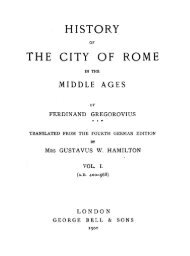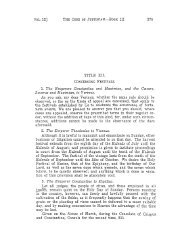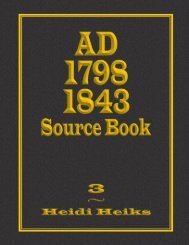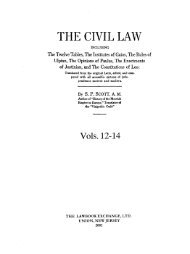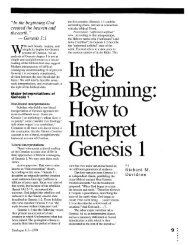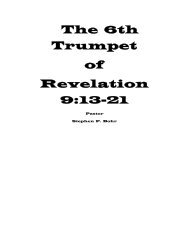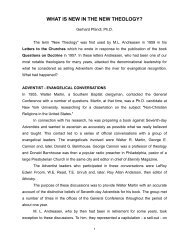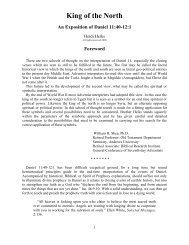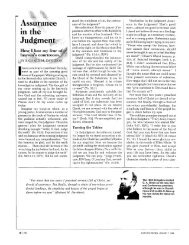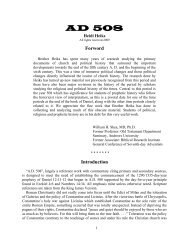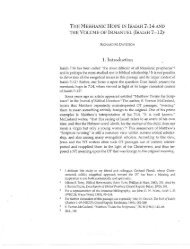Create successful ePaper yourself
Turn your PDF publications into a flip-book with our unique Google optimized e-Paper software.
<strong>Judgment</strong> <strong>in</strong> <strong>Daniel</strong> 7fire ("flames dE [of] fire"). Thesecond predicate nom<strong>in</strong>ative ofthis bicolonconsists, on the other hand, ofa construct cha<strong>in</strong> <strong>in</strong> which the word for firecomes first ("fire of burn<strong>in</strong>g"). Thus the overall pattern of the bicolon <strong>in</strong>verse 9c is A:B:C: :~:C':B'. A k<strong>in</strong>d of m<strong>in</strong>i-chiasm occurs here at the endof this bicolon lead<strong>in</strong>g to the center of the poem.A chiasm ofanother type occurs on the otherside ofthe centerofthisstanza <strong>in</strong> the bicolon of verse lOa. The first colon of this bicolon beg<strong>in</strong>swith a nom<strong>in</strong>al subject ("a stream"), and it ends with a verb ("preceded").Its second colon beg<strong>in</strong>s with a verb ("went forth") and ends with a prepositionalphrase ("before it"). Thus its pattern is A:B: :B:C, <strong>in</strong> which theverbsare arranged back-to-back at the end and beg<strong>in</strong>n<strong>in</strong>g of their respectivecola. Thus a partial chiasm occurs at the end ofverse 9c and another oneoccurs <strong>in</strong> verse lOa. These two chiasms bridge the center ofthe poem. Thisillustrates the general rule that chiasms <strong>in</strong> biblical poetry commonly occurat the center of the poems <strong>in</strong> which they are found.The two bicola from verses 9c and lOa which form this C:C' couplet atthe center of the stanza are written with the same 3:3 meter. They alsoconveycomplimentary ideas. Thefirst describes God's glorious throne; thesecond depicts its movement.A study ofthe verbs <strong>in</strong> verse lOa gives support to the latter idea. TheAramaicpa tel participle naged. (preceded) which occurs at the end of itsfirst colon derives from the same root as the preposition neged. whichmeans "toward, <strong>in</strong> the direction of." The idea appears to be thatflames offiery glory flowed or poured forth <strong>in</strong> front of the throne <strong>in</strong> a specific direction.The second participle, naIl-eq, expresses the same idea, s<strong>in</strong>ce it means"to go forth, come forth," and is used here with the preposition "before."<strong>Daniel</strong> 2:13 uses this verb to refer to the decree that "went forth," and <strong>in</strong><strong>Daniel</strong> 3:26 it expresses Nebuchadnezzar's command to the three Hebrewworthies to "come forth" from the fiery furnace. Even though the morespecific subject ofthese verbs <strong>in</strong>verse lOa is the fire from the throne ratherthan the throne itself, they nevertheless convey the idea of motion anddirection: the throne ofGod moved and came to the place where it was tobe established.Thus both ofthe verbs ofthis bicola <strong>in</strong>dicate that the flames appeared<strong>in</strong> front ofthe chariot-throne, flash<strong>in</strong>g "toward" the position to which thethrone was bear<strong>in</strong>g its div<strong>in</strong>e occupant. The emphasis of this stanza uponthe throne of God (rather than upon God Himself) appears to be due tothe prom<strong>in</strong>ence ofits activity <strong>in</strong> br<strong>in</strong>g<strong>in</strong>g God <strong>in</strong>to this scene ofjudgment.120



